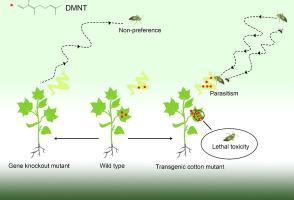当前位置:
X-MOL 学术
›
J. Adv. Res.
›
论文详情
Our official English website, www.x-mol.net, welcomes your feedback! (Note: you will need to create a separate account there.)
Engineering DMNT emission in cotton enhances direct and indirect defense against mirid bugs
Journal of Advanced Research ( IF 11.4 ) Pub Date : 2024-05-26 , DOI: 10.1016/j.jare.2024.05.022 Dong Teng , Danfeng Liu , Adel Khashaveh , Beibei Lv , Peiyao Sun , Ting Geng , Hongzhi Cui , Yi Wang , Yongjun Zhang
Journal of Advanced Research ( IF 11.4 ) Pub Date : 2024-05-26 , DOI: 10.1016/j.jare.2024.05.022 Dong Teng , Danfeng Liu , Adel Khashaveh , Beibei Lv , Peiyao Sun , Ting Geng , Hongzhi Cui , Yi Wang , Yongjun Zhang

|
As an important herbivore-induced plant volatile, (3)-4,8-dimethyl-1,3,7-nonatriene (DMNT) is known for its defensive role against multiple insect pests, including attracting natural enemies. A terpene synthase (GhTPS14) and two cytochrome P450 (GhCYP82L1, GhCYP82L2) enzymes are involved in the synthesis of DMNT in cotton. We conducted a study to test the potential of manipulating DMNT-synthesizing enzymes to enhance plant resistance to insects. To manipulate DMNT emissions in cotton and generate cotton lines with increased resistance to mirid bug Biosynthesis and emission of DMNT by cotton plants were altered using CRISPR/Cas9 and overexpression approaches. Dynamic headspace sampling and GC–MS analysis were used to collect, identify and quantify volatiles. The attractiveness and suitability of cotton lines against mirid bug and its parasitoid were evaluated through various assays. No DMNT emission was detected in knockout CAS-L1L2 line, where both and were knocked out. In contrast, gene-overexpressed lines released higher amounts of DMNT when infested by . At the flowering stage, L114 (co-overexpressing and ) emitted 10–15-fold higher amounts than controls. DMNT emission in overexpressed transgenic lines could be triggered by methyl jasmonate (MeJA) treatment. and its parasitoid were far less attracted to the double edited CAS-L1L2 plants, however, co-overexpressed line L114 significantly attracted bugs and female wasps. A high dose of DMNT, comparable to the emission of L114, significantly inhibited the growth of , and further resulted in higher mortalities. Turning down DMNT emission attenuated the behavioral preferences of to cotton. Genetically modified cotton plants with elevated DMNT emission not only recruited parasitoids to enhance indirect defense, but also formed an ecological trap to kill the bugs. Therefore, manipulation of DMNT biosynthesis and emission in plants presents a promising strategy for controlling mirid bugs.
中文翻译:

棉花中的 DMNT 排放工程增强了对蚜虫的直接和间接防御
作为一种重要的食草动物诱导植物挥发物,(3)-4,8-二甲基-1,3,7-九萘三烯 (DMNT) 因其对多种害虫的防御作用(包括吸引天敌)而闻名。棉花中 DMNT 的合成涉及一种萜烯合酶 (GhTPS14) 和两种细胞色素 P450 (GhCYP82L1、GhCYP82L2) 酶。我们进行了一项研究来测试操纵 DMNT 合成酶增强植物对昆虫的抵抗力的潜力。为了操纵棉花中的 DMNT 排放并产生对蝽病具有增强抗性的棉花品系,使用 CRISPR/Cas9 和过表达方法改变了棉花植物的 DMNT 生物合成和排放。使用动态顶空进样和 GC-MS 分析来收集、鉴定和量化挥发物。通过各种测定评估了棉花品系对蝽及其寄生蜂的吸引力和适用性。在敲除 CAS-L1L2 系中未检测到 DMNT 发射,其中 和 均被敲除。相比之下,基因过表达的品系在感染 .在开花阶段,L114(共同过表达 和 )释放的量比对照高 10-15 倍。茉莉酸甲酯 (MeJA) 处理可触发过表达转基因株系中的 DMNT 发射。其寄生蜂对双重编辑的 CAS-L1L2 植物的吸引力要小得多,然而,共过表达的 L114 系显着吸引了臭虫和雌性黄蜂。与 L114 的排放量相当的高剂量 DMNT 显着抑制了 的生长,并进一步导致更高的死亡率。减少 DMNT 排放减弱了对棉花的行为偏好。 DMNT排放量升高的转基因棉花植株不仅可以招募寄生蜂来增强间接防御,还可以形成生态陷阱来杀死害虫。因此,操纵植物中 DMNT 的生物合成和排放为控制蝽类提供了一种有前景的策略。
更新日期:2024-05-26
中文翻译:

棉花中的 DMNT 排放工程增强了对蚜虫的直接和间接防御
作为一种重要的食草动物诱导植物挥发物,(3)-4,8-二甲基-1,3,7-九萘三烯 (DMNT) 因其对多种害虫的防御作用(包括吸引天敌)而闻名。棉花中 DMNT 的合成涉及一种萜烯合酶 (GhTPS14) 和两种细胞色素 P450 (GhCYP82L1、GhCYP82L2) 酶。我们进行了一项研究来测试操纵 DMNT 合成酶增强植物对昆虫的抵抗力的潜力。为了操纵棉花中的 DMNT 排放并产生对蝽病具有增强抗性的棉花品系,使用 CRISPR/Cas9 和过表达方法改变了棉花植物的 DMNT 生物合成和排放。使用动态顶空进样和 GC-MS 分析来收集、鉴定和量化挥发物。通过各种测定评估了棉花品系对蝽及其寄生蜂的吸引力和适用性。在敲除 CAS-L1L2 系中未检测到 DMNT 发射,其中 和 均被敲除。相比之下,基因过表达的品系在感染 .在开花阶段,L114(共同过表达 和 )释放的量比对照高 10-15 倍。茉莉酸甲酯 (MeJA) 处理可触发过表达转基因株系中的 DMNT 发射。其寄生蜂对双重编辑的 CAS-L1L2 植物的吸引力要小得多,然而,共过表达的 L114 系显着吸引了臭虫和雌性黄蜂。与 L114 的排放量相当的高剂量 DMNT 显着抑制了 的生长,并进一步导致更高的死亡率。减少 DMNT 排放减弱了对棉花的行为偏好。 DMNT排放量升高的转基因棉花植株不仅可以招募寄生蜂来增强间接防御,还可以形成生态陷阱来杀死害虫。因此,操纵植物中 DMNT 的生物合成和排放为控制蝽类提供了一种有前景的策略。











































 京公网安备 11010802027423号
京公网安备 11010802027423号